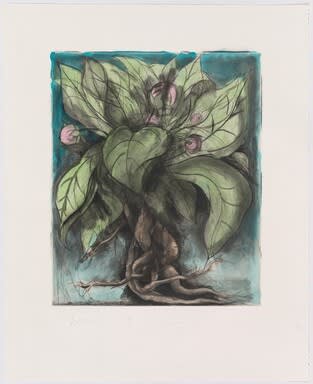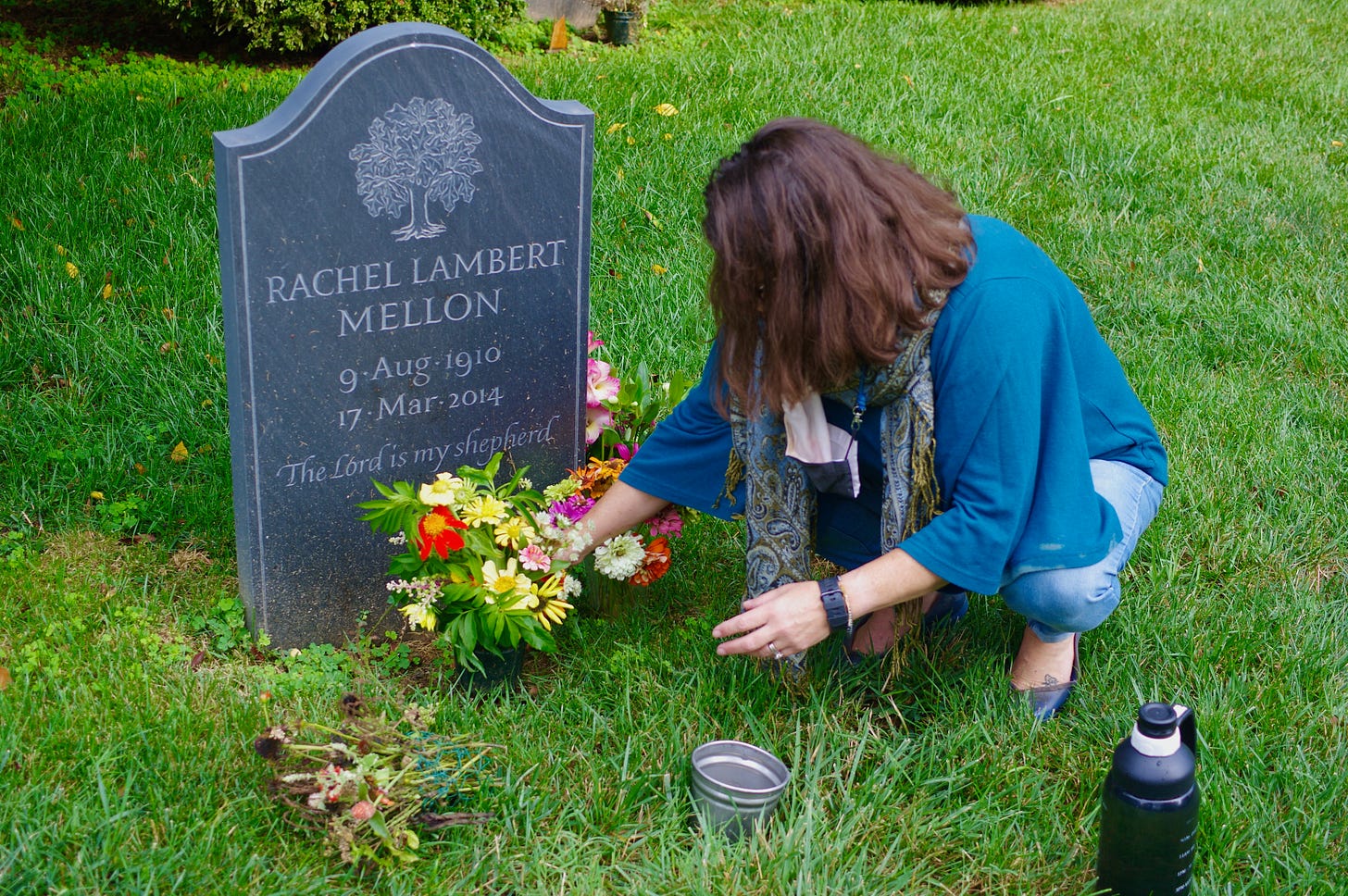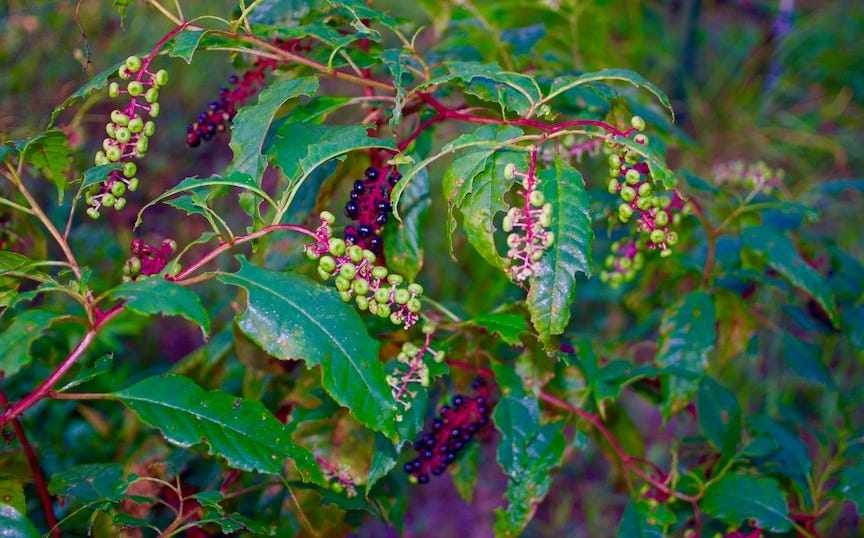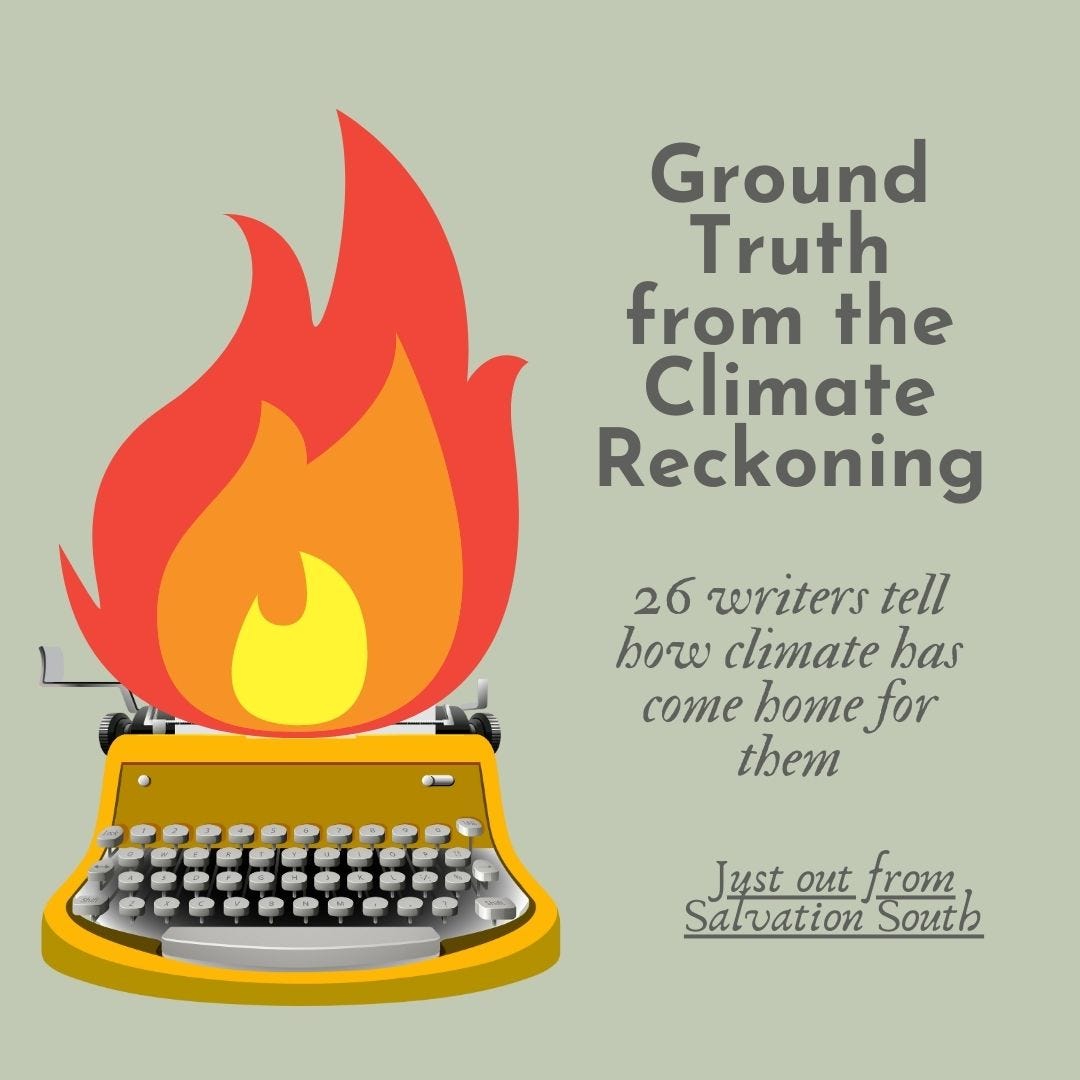In Bunny Mellon’s library hangs a set of eight botanical paintings that appear medieval. The paintings are crude, created mostly from the muted inks of plants, and faded from the centuries. Yet they are not crude.
Each painting is of a single specimen—a silver thistle, for example—and in every painting, the plant rises from the earth surrounded by mushrooms, small flora, and other forest dwellers.
The eight paintings share another thing in common. Each represents a poison.
One of the images is a mandrake. Its painter has sketched the root to look whimsical, a Dr. Seuss character, tawny brown and slightly hairy, albeit decidedly human and youthful. The mandrake has two legs that close like a dancer in a pirouette. Its two hairy arms cover its genitals. From its head sprout leaves and the globes of fruit, which are the size of black walnuts.
I am reminded, looking at this painting, of how much story is constantly lost.
Was the painter a man or a woman or some other identity entirely?
How much of the plant’s lore is captured here?
Is there an impishness to the comical, human-like body?
Is there a lesson in these paintings, a how-to?
Is the painter trying to convey hallucinogenic properties?
Is there malevolence?
Are these plants abortifacients?
The Gated
We live most of our lives in staggering ignorance. We’re constantly told not to think for ourselves, not to ask questions, not to listen to alternatives. We’re instructed to accept the dominant narratives. We listen to the influencers, who tell us what to think, and we listen to the capitalists, who need us to think like they do. We accept the simple answers because that’s what is asked of us and because deconstructing the complications of life, especially modern life, is arduous, is difficult, is lonely.
And in a post-industrial society we have learned to gate out all but the most potent senses. We take in the car horns, the smell of smoke, chemical tastes, heat, and of course anything we can see, if we dare look. How many people pass you on the sidewalk with their eyes straight ahead?
Meanwhile, dozens of other senses atrophy, especially the most important one, the one that informs all, the sixth.
To get back our innate wisdom, the late herbalist and thinker Stephen Harrod Buhner suggested that we ask of everything, “How does this feel?”
The Question
I stand before the painting of the mandrake, asking that question. How does this painting feel?
It feels mysterious. It feels confusing. It feels as if two messages are being conveyed, one that should be obvious and one that is hidden, a secret. In my ignorance I don’t know either of them.
I am doing the same thing with this essay. I am conveying two things. One should be obvious. One is hidden.
The Library
The library at Oak Spring Gardens, where I lived for a month on a writing retreat, houses the collections of Bunny Mellon. Mellon was a Listerine and Gillette heiress born at the end of the Gilded Age, whose marriage into incredible wealth doubly enabled her to enjoy a life of luxury. She loved gardens, and she used her substantial means to pursue things botanic—botanical illustrations, botanical paintings, botanical volumes. She collected the finest, meaning the first edition, the rare, the hand-colored, the ancient and historic, the cared for. She especially was fascinated by herbaria.
When I would visit the library at Oak Spring, the month I was there, the librarian, Tony Willis, set me at a table to myself. The table was covered with a thick ruglike cloth for protecting the books, and Tony supplied bolsters to keep book spines from breaking.
When Mrs. Mellon was alive, Tony brought her things she wanted to see, retrieving them from shelves and vaults and cabinets, the same as he does now for researchers lucky enough to obtain access to these world treasures. Mrs. Mellon would ask for a book, and Tony would seek it in the card catalog of his brain, retrieve it, and bring it to her.
The History
Now I stand before eight botanical paintings. These botanicals are dated circa 1630 and were taken from a village apothecary in the Loire (luh-WAAR) valley of France. The village of origin is believed to be Saumur (SAH-mur), a place in western France where humans have lived for thousands of years. At the south of town is a dolmen, a stone monolith 23 meters long built from fifteen large slabs of the local Tuffeau (TUU-foo) stone. These dolmen were built by native people, the Indo-Europeans.
My ancestors. My grandmothers and grandfathers.
By the 7th century, descendants of Norse Vikings were pushing into coastal France mostly from what is now Denmark, but also Norway and Sweden. As the Vikings invaded and conquered—colonized—these territories, they intermingled with Indo-Europeans and Gallo-Romans, becoming an ethnic group, the Normans, and adopting the Catholicism of the Romans. They spread ideas of Catholic piety, a centralized royal government, and feudalism.
In the wake of the Norman invasions, mystical, land-based religions went underground.
In 845 Normans attacked the settlement at Saumur, causing villagers to flee inland for their lives. After a while the villagers returned, and they built an immense chateau as fortification to protect the Loire River crossing.
The Recent Past
Perhaps 845 sounds like an ancient number to you. But the longer I study history, the more immediate and recent the past becomes. My father lived 83 years. 845 plus 83 is 928, plus another 83 is 1011, and thus only fourteen lifetimes separate me from the invasion of the Normans at Saumur, which caused the land-based peoples there to flee, which began to cause them to visit the dolmen in private, maybe even at night, and caused them to question their relationships to the land, to the spirits of the land, to plants, to animals, to sky.
The native people labored to erect the dolmen at Saumur and then gathered at it for their ceremonies. They used their sixth sense more than the usual five. They had less disrupted biota to feed them, they had for centuries been working out intricate, highly intelligent, and profound relationships to plants. They had heard the mandrake screaming. They had felt Datura caressing them like a lover.
In the ensuing centuries, Saumur would become home to many from the wealthy and educated class, including royalty. They increasingly turned toward the Protestant ideas of John Calvin, becoming known as Huguenots. The histories of Saumur point to the difficult years of the Wars of Religion. People who dared to think differently, to believe differently, were being persecuted, also tortured, also killed.
What, oh what, has changed?
In 1598, the day before yesterday, King Henry IV signed the Edict of Nantes (naant) into law. Although it upheld Catholicism as the established religion, it granted some civil rights and privileges to people of other faiths, including the Huguenots.
It would have been during this time of laxity, in the freedom granted by the Edict, that an unknown someone circa 1630 created eight paintings of plant poisons found in a poison shop and now hanging in the rare-book library at Oak Spring.
Why in 1630 would an unknown painter have chosen these eight plants? Were there others on the walls of the apothecary that got left behind? And why do all of them, in some way or another, include the possibility of death?
The Skull and Crossbones
Mandrake--POISON
Datura—DEADLY POISON. Even the scent can kill you.
Butcher's broom (Ruscus hypoglossum)--TOXIC, causes severe stomach cramps.
False helleborine (Veratrum album)--POISON
Lavender (Lavandula cf. stoechas)--the oil is HEPATOTOXIC
Siberian frittilary –HIGHLY TOXIC, especially the bulb.
Silver thistle--Carlina oxide is thought to be TOXIC, used in Swedish bitters.
Aloe—The TOXIN occurs in the saponins (latex in the green skin).
The Apothecaries
In Europe during the Middle Ages, I learned, people sold and supplied poisons and also potions, meaning combinations of poisons deemed more effective than a single ingredient. These sellers were known as apothecaries1. In time the shops themselves were known by the same term.
In The Canterbury Tales, written sometime between 1387 and 1400, Chaucer writes
And forth he goes – no longer he would tarry –
Into the town unto a ‘pothecary
And prayed him that he woulde sell
Some poison…
In 1424 Magister Santes de Ardoynis wrote The Book of Venoms, which described the poisons of the day and also their antidotes.
By the Renaissance, poison was becoming an assassin or murderer’s tool of choice. Anyone in power, especially royalty, had to be take care not to be poisoned. I’ve read that Henry IV, while visiting the Louvre, only ate eggs he cooked for himself and drank water he drew for himself. In 1662 Louis XIV forbade the sale of certain poisons and limited sales of all.
Were these paintings simply decoration for apothecary walls?
Were they an herbal?
Were they an underground message?
The Lunch
I am deep into books but I begin to notice activity in the reserve of the library, a table quietly being moved. Tony comes by and invites me to eat with the staff. Suddenly it’s as if Mrs. Mellon is yet alive, and she’s taking lunch at her beloved library. Everyone is lunching together. In the small kitchen someone has laid out tuna salad and Portuguese bread, green salad and chips. We share a pleasant, gracious, memorable meal. I have no fear of poison.
The Medicine
But the poison is also the medicine. Pokeweed, which grows as profusely at Oak Spring as it does at my farm, is toxic; and yet a tincture made from the root can be (sparingly, judiciously) used in the treatment of cancer.
The Psychedelics
Some plants, as we know, are labeled “poisonous” because they are psychedelic. This is the case for Amanita muscaria, for example.
I have friends who “work with poisonous plants” and when I say “work,” I mean they consume them. I’ve been following the work of Amanita Dreamer, pseudonym of a woman unable to get off benzodiazepines whose story of how a psychedelic mushroom saved her life is mesmerizing. (I first heard it on the Mythic Medicine podcast.)
Also see the book Microdosing with Amanita Muscaria: Creativity, Healing, and Recovery with the Sacred Mushroom, out from Inner Traditions.
Anxiety, panic, PTSD, and even more serious mental health issues are at epidemic levels. Rates of drug use, legal and illegal, are high high high. Humans are not as loving, communal, placid, and happy as we should be. Politics keeps us divided. Fox News divides us.
The Divisions
Traveling this past weekend I spoke to many people who are suffering the divisions engendered by media and meanness. A man told me that his 11-year-old granddaughter took her own life with pills after being bullied at school. A woman told me she lost a good friend because she didn’t vote for Trump. Another woman told me another version of that story. A parent told me he had a come-to-Jesus talk with his adult son, who didn’t realize how disparaging he was. An unpublished writer told me she has finished a book about how none of her family survived heroine addiction.
The List of Poisons
Bullying
Cancelling
Assuming
Judging
Stereotyping
Hating
Blaming
Silencing
Dividing
It’s easy to throw poison around. And it’s easy to find yourself on the receiving end of poison—cancel culture, misconceptions, preconceptions, victim culture, oppression. I suppose divisions are more profitable than unifications.
I’ve thrown poison darts, and I’ve had them thrown at me, as have we all.
Thinking and acting rationally and lovingly, patiently and inclusively, in normal everyday situations can take enormous effort. Yes. But in the long run, toxicity and poison kills.
The Mandrake’s Message
I stood in front of the mandrake, asking what is was saying to me. It said this:
The story is always—always—more complicated than we want it to be. So many dominant paradigms in our world distill layers of human complexity and story down to one, and so many of us, childlike in our naivete, embrace that story and use it as a tool to diminish and demolish. We assume. We take sides.
What the mandrake said to me: If you are going to judge another, take the time to get the whole story. Don’t let dominant narratives push your thinking into danger zones. Practice the courage it takes to ask questions, to listen, and to think for yourself.
It said: Use me as medicine.
Two More Things
Ground Truth from the Climate Reckoning
I collected 26 flash essays, starting with writers in my Journaling Earth course and my Nature Writing Masterclass, to cover a map of the southern U.S. with stories of how the climate crisis is coming home for us. Thanks to editor Chuck Reece, this flash anthology published in Salvation South this week. Please share it on your social media and with your friends.
The Magical Craft of Creative Nonfiction
If you’ve been wanting to take my beginning creative nonfiction course, you have a good chance starting in January 2024. The course runs for six weeks, Wednesday evenings 7-9 pm Eastern US Time. It covers getting published, memoir, micro-memoir, flash essay, writing scenes, and avoiding the curse of narrative. I’ll do a session of live editing on volunteer work, and also we sponsor an Open Mic, where writers in the course are invited to read. The cost is $500. You can register here.
[Old French apotecaire, from Latin apothēca, meaning storehouse, from Greek apothēkē : apo meaning away + thēkē meaning receptacle, or away from the storehouse.]












I love this! I've been on a mission to recover my 6th sense for several years now. It's always been there but I haven't always given it the attention it deserves. The world is so full of divisiveness these days and the only respite I can find from it is in the woods or river. Thank you for being you and putting this essay together!
This is a mind-altering look at poison! Thanks Janisse for sharing your journey, your knowledge, and your wisdom!